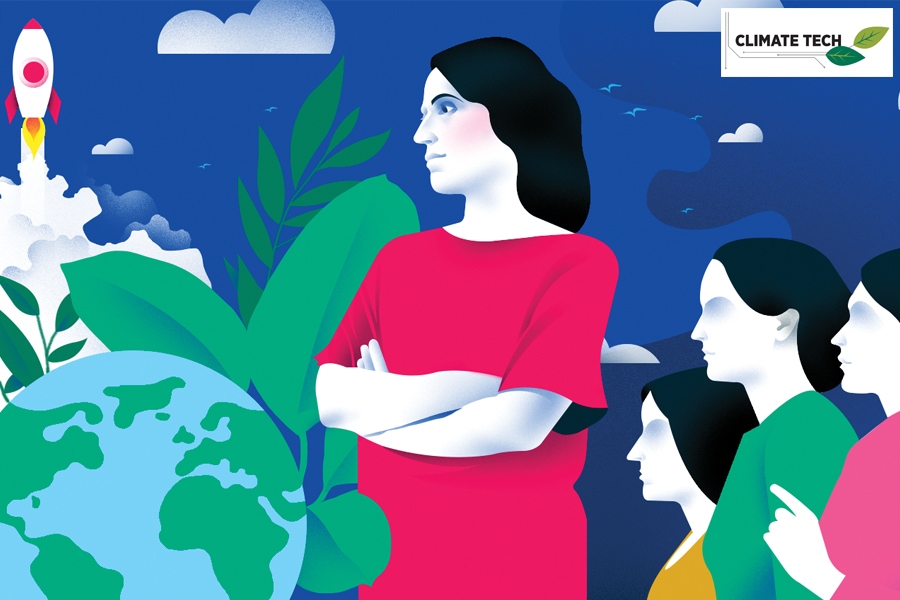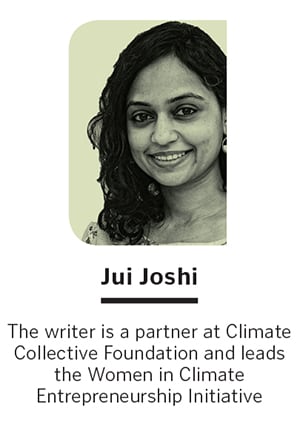
It's time to build a resilient green economy that is diverse and inclusive
Jui Joshi, partner at Climate Collective Foundation, and the lead of Women in Climate Entrepreneurship Initiative, writes on the importance of moving beyond a gender-blind approach
 Women need to be initiated into the idea of entrepreneurship at the university/graduation level. Women in India also are less likely to be able to capitalise on the opportunities offered by the local environment
Illustration: Sameer Pawar
Women need to be initiated into the idea of entrepreneurship at the university/graduation level. Women in India also are less likely to be able to capitalise on the opportunities offered by the local environment
Illustration: Sameer Pawar
 Having worked extensively at the intersection of climate tech entrepreneurship and gender, a question that mushrooms up in conversations is that climate itself is a complex problem; why increase complexity by introducing gender focus as an ‘add on’. This question warrants a discussion as funding for impact is limited.
Having worked extensively at the intersection of climate tech entrepreneurship and gender, a question that mushrooms up in conversations is that climate itself is a complex problem; why increase complexity by introducing gender focus as an ‘add on’. This question warrants a discussion as funding for impact is limited.
Two key factors to consider are: 1) Women are disproportionally impacted by the climate crisis and 2) women face inherent biases to be implementers in climate action in a meaningful way. It flows from this that we should be focusing on gender in climate. However, one can argue that women can be passive recipients of the action as solving the imminent crisis should take precedence over sub-goals of equity. The lesser-known facts that advocate strongly for women to be active participants are that technology companies led by women are more capital-efficient, achieve 35 percent higher ROI (return on investment), and, when venture-backed, achieve 12 percent higher revenue than startups run by men, according to the Kauffman Foundation.
The case for higher innovative technologies’ commercialisation in climate was highlighted by the International Energy Agency report as the key to reaching a net-zero emission target. Technologies at the prototype or demonstration stage are projected to contribute to 35 percent of emission reduction by 2070 with a further 40 percent to come from technologies at early stages of adoption. We need climate startups in large numbers. And we need women equally leading these startups as investing in women makes business sense. A CPI Global Landscape for Finance report noted very low percentages of climate investment being gender tagged. We need to move beyond the gender-blind approach to tackle climate change.
With the pandemic exacerbating the urgency of climate action and at the same time significantly increasing the gender gap, these are clearly co-development goals that need to be fulfilled for a resilient sustainable recovery.
Disproportionate impact
As women are more dependent on natural resources, particularly in rural and forest areas, and more vulnerable, they are disproportionately impacted by the climate crisis. The most talked-about example is where women need to walk further and further for access to water due to pollution or drying up of water bodies. Similarly, women being the primary users of fuel for cooking in households are closely impacted by the type of fuel used. Women traditionally are the ones to manage waste in the households and are the majority in the informal economy in waste management. These are just a few examples of inequity. This being the case, women closely understand the problems on the ground and are more likely to develop the right solutions. For example, startups led largely by women focusing on sustainable menstruation with products ranging from menstrual cups to biodegradable and even reusable sanitary napkins are proliferating the market. There are some great women-led startups in energy access along with microenterprises in clean cooking stoves and solar lamps. These solve problems on the ground, especially those faced by women resulting in environmental and social co-benefits.








